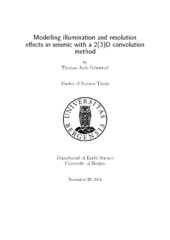Modelling illumination and resolution effects in seismic with a 2(3)D convolution method
Master thesis
Permanent lenke
https://hdl.handle.net/1956/18766Utgivelsesdato
2018-12-14Metadata
Vis full innførselSamlinger
- Department of Earth Science [1050]
Sammendrag
The aim of seismic modelling is to generate modelling cases with the highest degree of realism possible, where the benchmark is the expensive (expertise needed, extensive time-cost) finite-difference modelling method. A popular alternative is the much more efficient and simpler convolution modelling, where the standard is the 1D convolution method. However, this method only accounts for vertical resolution effects at best. Another alternative is a 2(3)D convolution modelling method, which estimates Point-Spread Functions (PSF) used to simulate a full 3D resolution and illumination effects in seismic imaging. In this study, the main objective is to examine the effects that lateral resolution and limited illumination have on 2(3)D prestack depth-migrated seismic images using the PSF-based 2(3)D convolution method. Four modelling cases were considered; a steep wedge model, two outcrop models (Franklin Mountains, USA and Beckwith Plateau, USA), and finally a 3D reservoir model from an actual cave, Setergrotta (Norway), as a proxy for a paleokarst reservoir. The results of the modelling cases revealed a relation between the vertical and lateral (horizontal) resolution, in addition to significant improvements in the modelled seismic after introducing lateral resolution and illumination effects. These effects caused a smoother and more realistic seismic than the 1D convolution, which struggled with complex structures. The differences were especially noticeable at the 3D Setergrotta model, where the lack of lateral resolution effects in the 1D convolution results caused highly unrealistic seismic. Based on the modelling results, my conclusions are that the vertical and lateral resolution effects are not two independent entities, and should thus be modelled together. In addition, the results illustrated that 1D convolution modelling is not a sufficient modelling method in such complex models, and should be replaced with the 2(3)D convolution modelling method.
